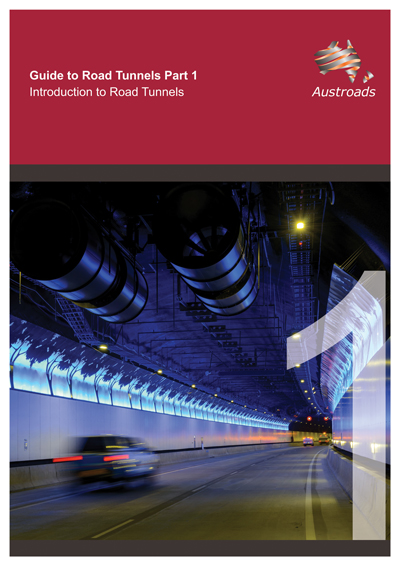Tunnels

Guide to Road Tunnels Part 1: Introduction to Road Tunnels
- Publication no: AGRT01-24
- ISBN: 978-1-922700-43-8
- Published: 23 September 2024
- Edition: 3.0
- PDF (free) Download
Guide to Road Tunnels Part 1 outlines the structure of the Guide to Road Tunnels, while also introducing road tunnel planning. Part 1 describes key issues and considerations related to the implementation process, road tunnels in the context of a safe system, sustainability, general planning, structural design, drainage, geology and the environment. It also deals with critical considerations such as flood protection, fire and life safety, ventilation and risk management.
The update to Edition 3.0 of this Guide is detailed in the report Sustainability in Road Tunnels: Updating the Guide to Road Tunnels.
- 1. Introduction
- 1.1 Structure of the Guide to Road Tunnels
- 1.2 Purpose of the Guide
- 1.3 Scope of Part 1
- 1.4 Application
- 1.5 Emerging issues
- 1.6 Sustainability requirements
- 2. Overarching Requirements of Road Tunnels
- 2.1 Providing a Safe System
- 2.2 Providing a sustainable tunnel
- 2.3 Defining road tunnels
- 2.4 Planning for road tunnels
- 2.5 Design of road tunnels
- 3. Implementation Process
- 3.1 Overview
- 3.2 Operating procedures
- 3.3 Construction
- 4. Sustainability
- 4.1 Introduction
- 4.2 Defining sustainability
- 4.2.1 Sustainability
- 4.2.2 Infrastructure sustainability
- 4.2.3 Road tunnel sustainability
- 4.3 Interaction of the sustainability pillars
- 4.4 Sustainability impact of road tunnel development
- 4.5 Consideration of a circular economy
- 4.6 Sustainable development and the Sustainable Development Goals
- 4.7 Overarching requirements for sustainable tunnel development
- 4.7.1 Introduction
- 4.7.2 Overall approach
- 4.7.3 Rating schemes
- 4.8 Achieving sustainability
- 5. General Planning Requirements
- 5.1 Introduction
- 5.1.1 General
- 5.1.2 Process scope and output
- 5.1.3 Output of the road tunnel planning process
- 5.2 Issues for consideration
- 5.3 Land acquisition and tenure
- 5.4 Hazard identification and risk management
- 5.4.1 Introduction
- 5.4.2 Risk assessment
- 5.4.3 Risk registers
- 5.5 Construction issues
- 5.5.1 Overview
- 5.5.2 Constructability
- 5.5.3 Workplace health and safety
- 5.5.4 Groundwater management
- 5.5.5 Vibration
- 5.5.6 Sustainability
- 5.6 Regulatory requirements
- 5.6.1 National legislation
- 5.6.2 State legislation
- 5.6.3 Project specific legislation
- 5.1 Introduction
- 6. Tunnel Design Considerations
- 6.1 Introduction
- 6.2 Safety in design
- 6.3 Sustainability
- 6.3.1 Sustainability impacts and opportunities
- 6.4 Site investigations
- 6.5 Human factors
- 6.6 Design life, serviceability and resilience
- 6.7 Traffic considerations
- 6.7.1 General considerations
- 6.7.2 Analysis techniques
- 6.7.3 Capacity analysis
- 6.7.4 Ventilation
- 6.8 Movement of dangerous goods
- 6.9 Movement of combustible goods
- 7. Structural Design Considerations
- 7.1 Introduction
- 7.2 Design elements
- 8. Geometric Design
- 8.1 Introduction
- 8.2 Cross-section
- 8.2.1 General
- 8.2.2 Lane widths
- 8.2.3 Shoulders
- 8.2.4 Auxiliary lanes
- 8.2.5 Working width
- 8.2.6 Tunnel envelopes and vehicle clearance
- 8.2.7 Ramp connections, diverges and merges
- 8.2.8 Portal traffic diversion
- 8.3 Grade
- 9. Drainage and Flood Protection
- 9.1 Introduction
- 9.2 Drainage of the road surface
- 9.2.1 Introduction
- 9.2.2 Surface drainage
- 9.2.3 Spillage management
- 9.3 Flooding
- 9.3.1 Introduction
- 9.3.2 Flood protection at portals
- 9.4 Management of groundwater
- 9.5 Impacts of climate change
- 10. Geotechnical Considerations
- 10.1 Overview
- 10.2 Specific requirements for road tunnels
- 10.2.1 Introduction
- 10.2.2 The planning stage
- 10.2.3 The concept stage
- 10.2.4 The design stage
- 10.2.5 Supplementary geological investigations
- 10.2.6 Geological and geotechnical reports used by constructors
- 11. Functional Safety and Operations
- 11.1 Introduction
- 11.2 Traffic safety in tunnels
- 11.2.1 Introduction
- 11.2.2 Geometric requirements
- 11.2.3 Operational requirements
- 11.2.4 Traffic safety infrastructure
- 11.3 Fire and life safety
- 11.3.1 Introduction
- 11.3.2 Fire safety objectives
- 11.4 Ventilation
- 11.4.1 Introduction
- 11.4.2 Effects of tunnel location and form
- 11.4.3 Design criteria
- 11.4.4 Performance and other criteria
- 11.4.5 Fans
- 11.5 Lighting
- 11.6 Electrical supply
- 11.6.1 General requirements
- 11.6.2 Dual power supply
- 11.6.3 Uninterruptible power systems
- 11.7 Communications and monitoring
- 11.8 Operations
- 11.9 Maintenance
- 12. Environmental Considerations
- 12.1 Introduction
- 12.2 Considerations during the planning and design stage of road tunnel
- 12.3 Water quality
- 12.3.1 During construction
- 12.3.2 During operation
- 12.4 Air quality
- 12.4.1 During construction
- 12.4.2 During operation
- 12.5 Noise
- 12.5.1 During construction
- 12.5.2 During operation
- 12.6 Ground settlement and contamination
- 12.6.1 Ground Settlement
- 12.6.2 Ground contamination
- 12.7 Ecology
- 12.7.1 Introduction
- 12.7.2 During design and operation
- 12.7.3 During construction
- References
- Commentary 1 : Types of Tunnel Construction
- C1.1 Cut-and-cover tunnel
- C1.2 Pile wall tunnels
- C1.3 Top down
- C1.4 Cast-in-situ tunnel in a waterway
- C1.5 Immersed tube tunnels
- C1.6 Driven tunnels
Related publications
WEB-PROJECTS-24
Latest Tunnels News
